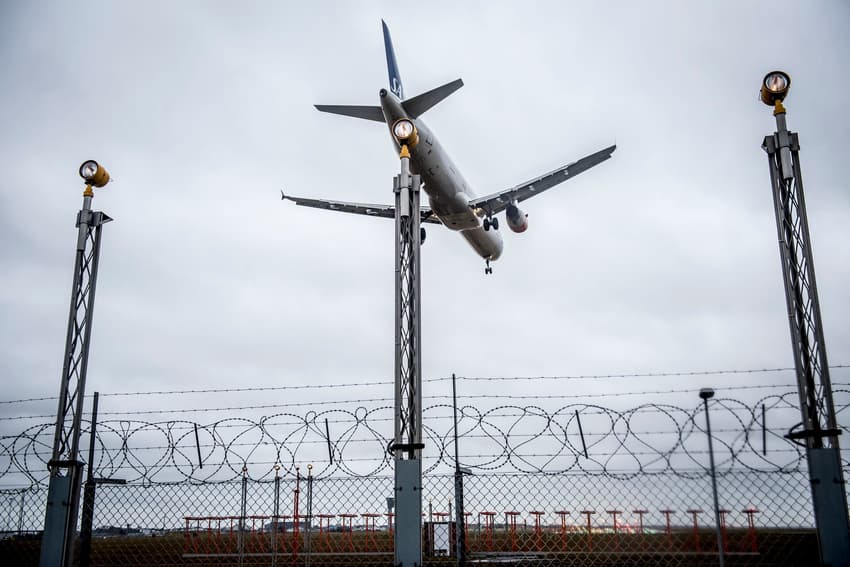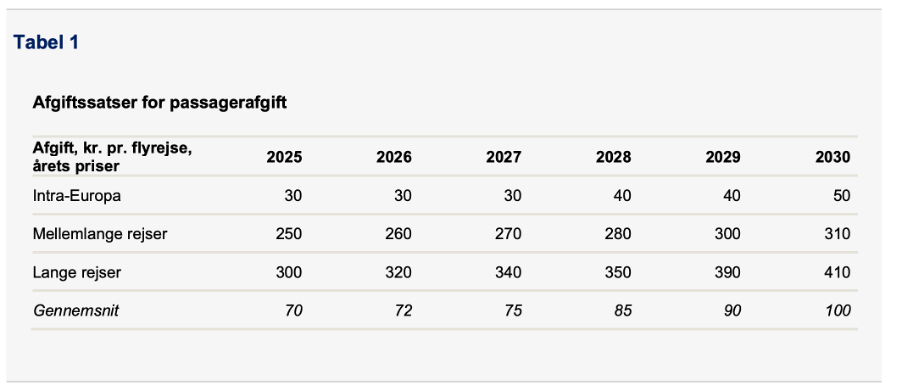UPDATE: How much will Denmark's new air travel taxes cost passengers?

Passengers on flights departing from Denmark will pay a new air travel tax from 2025, with the fee based on the destination of the flight, after the finalised version of the tax was agreed by the government.
The government on Friday announced a deal to implement the new air travel tax after reaching agreement with two opposition parties, the left-wing Red Green Alliance and Socialist People’s Party (SF).
The differentiated tax will be phased in from 2025, with full amounts payable from 2030. Once it has been fully implemented, its average cost will be 100 kroner per passenger per flight.
However, the taxes initially applicable – in 2025 – will be lower at 70 kroner on average, before rising gradually until 2030.
Different taxes are applied to three different categories of flight organised by distance: “within Europe”, “medium” and “long distance”.
Each step of the scale will be increased incrementally from the initial 2025 level to a higher value until it reaches the final rate, which will apply from 2030.

An overview of the new Danish air travel tax and timeline for its implementation. Values in Danish kroner, per passenger per flight. Key: "Intra-europa"= within Europe; "Mellemlange rejser"= Intermediate distance; "Lange rejser" = long distance. Graphic: Danish tax ministry
All passengers departing from airports in Denmark will be required to pay the tax, with the exception of passengers transferring at Danish airports.
The plan to introduce the tax was confirmed in November, with the final agreement presented Friday giving the exact details of the taxes at each phase of its implementation.
“This is an agreement which means it will cost an extra ‘flat 50’, as we call it, to fly domestically in Denmark and in Europe in 2030,” Tax Minister Jeppe Bruus said.
The taxes in the final version of the agreement are different from those in the proposal, with the tax for medium and long distance flights higher in than in the government’s original version. The tax for the short haul flights has meanwhile been reduced from 60 kroner in the proposal to 50 kroner in the agreement.
Bruus said the tax was “comparable with neighbouring countries”.
Which countries fall into the three categories?
The “intra-Europe” flight tax will be applied to all flights to European countries, including Turkey but not Russia. It will also be payable on Danish domestic flights and flights to Greenland and the Faroe Islands.
Flights to these destinations will cost 30 kroner in tax in 2025 and 50 kroner in 2030, when the tax is fully phased in.
“Medium distance” destinations include the United States and Canada (but not Mexico) to the west of Denmark. To the east and south, all of the Middle East and North Africa, as well as some sub-Saharan countries in West Africa (such as Côte d'Ivoire and Guinea, but not Ghana or Nigeria) are considered medium distance. Russia and Central Asia, including Pakistan, Iran and Afghanistan, are also in this category.
Flights to the intermediate distance destinations will cost 250 kroner in tax in 2025 and 310 kroner in 2030, when the tax is fully phased in.
Long distance or “other” flights as they are also termed encompasses all of Central and South America, the majority of sub-Saharan Africa and Asia west and south of (and including) China and India. The Pacific region is also unsurprisingly part of this section.
Flights to the long distance destinations will cost 300 kroner in tax in 2025 and 410 kroner in 2030, when the tax is fully phased in.
An exhaustive list of the countries in each category can be found in the full text of the agreement.
Why is Denmark introducing an air travel tax?
It is partly a measure aimed at reducing Denmark’s emissions, and thereby environmental impact.
As alluded to by Bruus, other European countries – Norway and France can be counted among them – already have air travel taxes comparable to the one to be brought in by Denmark.
The tax is expected to lead to a decrease in domestic flights of 7 percent in 2025 and 9 percent in 2030, the transport ministry has previously said.
Revenues from the tax are to be invested in several areas, notably in targeting a “green” domestic flight in Denmark, by 2025. Further to this, the government is aiming for fully green domestic flights by 2030, a long-standing ambition of the Danish government.
Revenues from the tax will also finance additional welfare for elderly people in Denmark, along with state support for regional airports in Sønderborg, Esbjerg and Central Jutland (Midtjylland).
The travel tax is expected to give the Danish state a revenue of 1.2 billion kroner in 2030.
Comments
See Also
The government on Friday announced a deal to implement the new air travel tax after reaching agreement with two opposition parties, the left-wing Red Green Alliance and Socialist People’s Party (SF).
The differentiated tax will be phased in from 2025, with full amounts payable from 2030. Once it has been fully implemented, its average cost will be 100 kroner per passenger per flight.
However, the taxes initially applicable – in 2025 – will be lower at 70 kroner on average, before rising gradually until 2030.
Different taxes are applied to three different categories of flight organised by distance: “within Europe”, “medium” and “long distance”.
Each step of the scale will be increased incrementally from the initial 2025 level to a higher value until it reaches the final rate, which will apply from 2030.

All passengers departing from airports in Denmark will be required to pay the tax, with the exception of passengers transferring at Danish airports.
The plan to introduce the tax was confirmed in November, with the final agreement presented Friday giving the exact details of the taxes at each phase of its implementation.
“This is an agreement which means it will cost an extra ‘flat 50’, as we call it, to fly domestically in Denmark and in Europe in 2030,” Tax Minister Jeppe Bruus said.
The taxes in the final version of the agreement are different from those in the proposal, with the tax for medium and long distance flights higher in than in the government’s original version. The tax for the short haul flights has meanwhile been reduced from 60 kroner in the proposal to 50 kroner in the agreement.
Bruus said the tax was “comparable with neighbouring countries”.
Which countries fall into the three categories?
The “intra-Europe” flight tax will be applied to all flights to European countries, including Turkey but not Russia. It will also be payable on Danish domestic flights and flights to Greenland and the Faroe Islands.
Flights to these destinations will cost 30 kroner in tax in 2025 and 50 kroner in 2030, when the tax is fully phased in.
“Medium distance” destinations include the United States and Canada (but not Mexico) to the west of Denmark. To the east and south, all of the Middle East and North Africa, as well as some sub-Saharan countries in West Africa (such as Côte d'Ivoire and Guinea, but not Ghana or Nigeria) are considered medium distance. Russia and Central Asia, including Pakistan, Iran and Afghanistan, are also in this category.
Flights to the intermediate distance destinations will cost 250 kroner in tax in 2025 and 310 kroner in 2030, when the tax is fully phased in.
Long distance or “other” flights as they are also termed encompasses all of Central and South America, the majority of sub-Saharan Africa and Asia west and south of (and including) China and India. The Pacific region is also unsurprisingly part of this section.
Flights to the long distance destinations will cost 300 kroner in tax in 2025 and 410 kroner in 2030, when the tax is fully phased in.
An exhaustive list of the countries in each category can be found in the full text of the agreement.
Why is Denmark introducing an air travel tax?
It is partly a measure aimed at reducing Denmark’s emissions, and thereby environmental impact.
As alluded to by Bruus, other European countries – Norway and France can be counted among them – already have air travel taxes comparable to the one to be brought in by Denmark.
The tax is expected to lead to a decrease in domestic flights of 7 percent in 2025 and 9 percent in 2030, the transport ministry has previously said.
Revenues from the tax are to be invested in several areas, notably in targeting a “green” domestic flight in Denmark, by 2025. Further to this, the government is aiming for fully green domestic flights by 2030, a long-standing ambition of the Danish government.
Revenues from the tax will also finance additional welfare for elderly people in Denmark, along with state support for regional airports in Sønderborg, Esbjerg and Central Jutland (Midtjylland).
The travel tax is expected to give the Danish state a revenue of 1.2 billion kroner in 2030.
Join the conversation in our comments section below. Share your own views and experience and if you have a question or suggestion for our journalists then email us at [email protected].
Please keep comments civil, constructive and on topic – and make sure to read our terms of use before getting involved.
Please log in here to leave a comment.